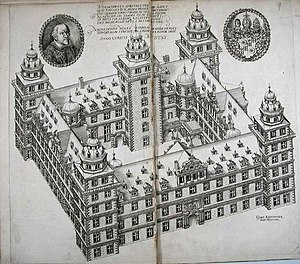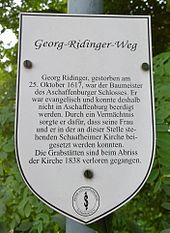Georg Ridinger
Georg Ridinger (also Riedtinger , Riedinger, Rüdinger or Redinger ) (baptized July 25, 1568 in Strasbourg ; † November 5, 1617 in Aschaffenburg ), was a German architect and builder of the late Renaissance and early Baroque periods .
biography

Ridinger, born from an Alsatian family coming and probably one day before his baptism on 24 July 1568 studied during his years of travel in France and Italy in particular the fortress architecture . When he returned to the German Empire, the knowledge he gained was used as a master builder. He is said to have helped shape the planning for Philippsburg Palace in Koblenz . Around 1595 he worked for the Ansbach margrave Georg Friedrich I, the elder in fortress construction, probably the Wülzburg . His simultaneous request for the position of foreman at the building yard in Strasbourg was rejected.
His most important and last work was the Johannesburg Castle , which he from 1605, his appointment was made but it was only on 13 March 1607 for the Mainz Archbishop and Elector Johann Schweikard of Kronberg as a second residence in Aschaffenburg built. The castle was inaugurated in 1614, but was not completed until 1618/1619 after the builder's death. His achievement can also be found in an extensive copperplate engraving, edited by Georg Keller , with views of and around Johannisburg Castle, which he himself published in Mainz in 1616.
In many German encyclopedias there is a different date of death "probably after 1628". Since Protestant he could faith in the Catholic not be buried and was one day after his death in west lying Aschaffenburg hanauischen evangelical Schaafheim laid to rest. The date of death given in the Schaafheim death register, October 26, 1617, refers to the Julian calendar that was still used in Schaafheim at that time . When the old Schaafheim church was demolished in the 19th century, its epitaph and family grave were also lost.
Johannisburg Castle, which he designed, is today considered to be one of the most important late Renaissance and early Baroque buildings in Germany.
A self-portrait of himself is preserved as a watercolor in the shopkeeper guild book 1582-1668 , which is in the city and monastery archive of Aschaffenburg.
Works
- Architectur of the maintzischen churfürstl. newen Schloßbawes St. Johannesburg zu Aschaffenburg , collection of engravings from and around Johannisburg Castle, Mainz 1616.
literature
- Georg Ridinger: Palatium Johannis Suicardi Principis. [The castle of Prince Johann Schweikhard]. Without place, 1611 (Johannisburg Castle in nine copper engravings)
- Erwin Hensler .: Ridinger, Georg . In: Allgemeine Deutsche Biographie (ADB). Volume 53, Duncker & Humblot, Leipzig 1907, pp. 353-356.
- Götz Czymmek: The Aschaffenburg Castle and Georg Ridinger. A contribution to the architecture of the Electorate of Mainz under Elector Johann Schweickhardt von Cronberg in 1978.
- Hans-Bernd Spies: Georg Ridinger (1568-1617). in: Fränkische Lebensbilder, Vol. 17, ed. v. Alfred Wendehorst (Publications of the Society for Franconian History, Series VII A: Fränkische Lebensbilder. New series of CVs from Franconia, vol. 17), Neustadt an der Aisch 1998, pp. 73-78.
- Peter Prange: Ridinger, Georg. In: New German Biography (NDB). Volume 21, Duncker & Humblot, Berlin 2003, ISBN 3-428-11202-4 , p. 555 ( digitized version ).
Web links
- Literature by and about Georg Ridinger in the catalog of the German National Library
- Aschaffenburg personalities
Individual evidence
- ↑ www.deutsche-biographie.de: Georg Ridinger
- ↑ see the late adoption of the calendar by the Protestants: Adoption of the Gregorian calendar
| personal data | |
|---|---|
| SURNAME | Ridinger, Georg |
| ALTERNATIVE NAMES | Ridinger, Georg; Riedinger, Georg; Riedtinger, Georg; Rüdinger, Georg; Ridinger, Georg von |
| BRIEF DESCRIPTION | architect |
| DATE OF BIRTH | baptized July 25, 1568 |
| PLACE OF BIRTH | Strasbourg |
| DATE OF DEATH | November 5, 1617 |
| Place of death | Aschaffenburg |


